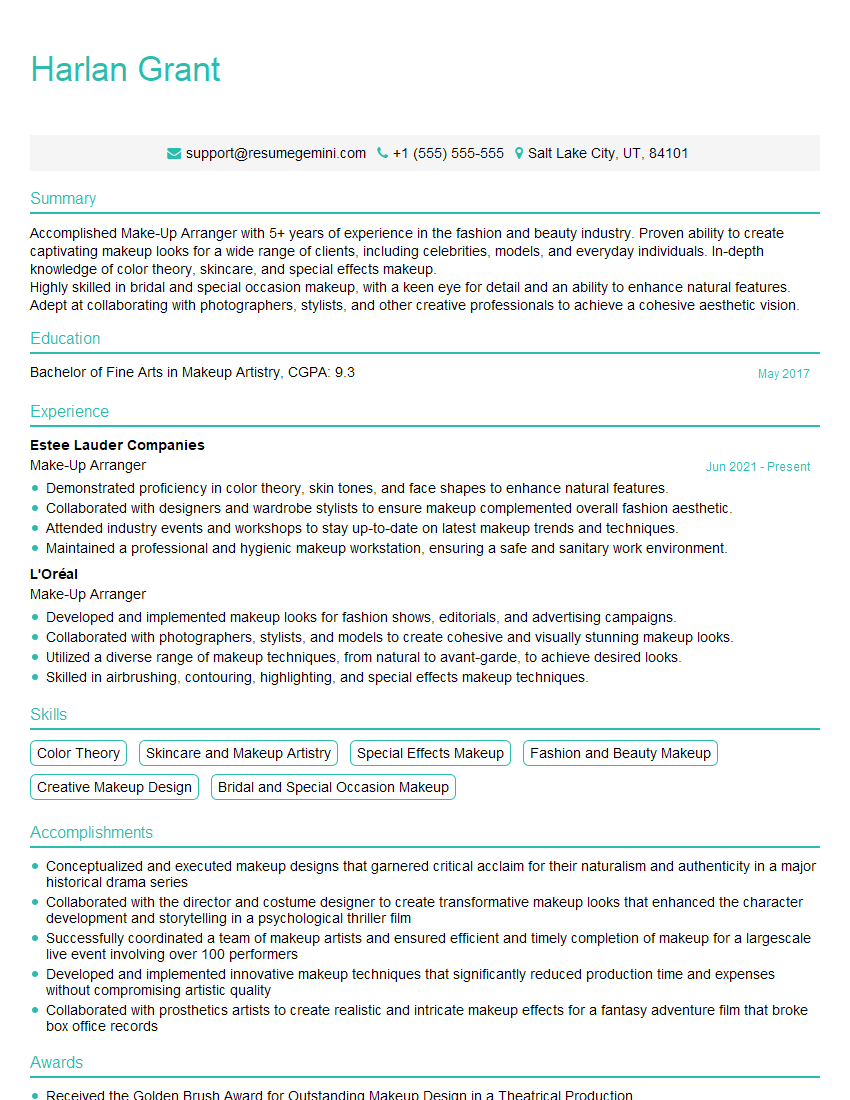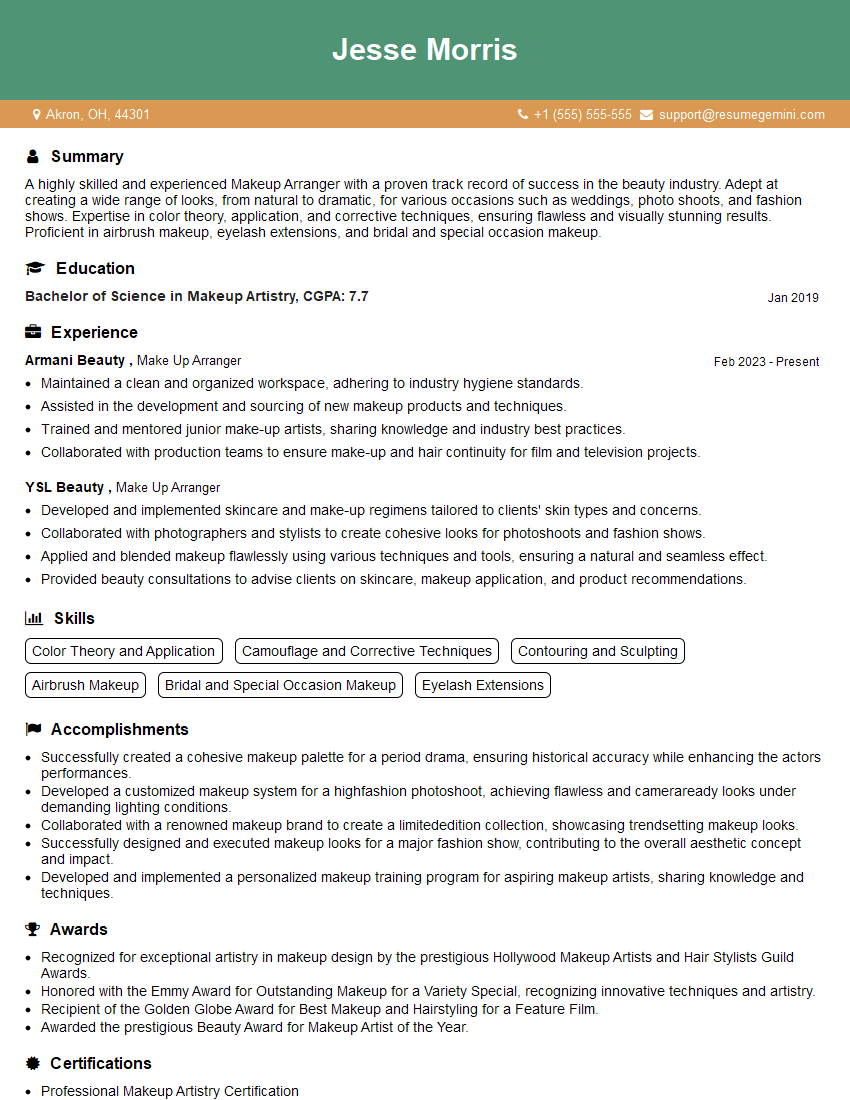Are you gearing up for an interview for a Make-Up Arranger position? Whether you’re a seasoned professional or just stepping into the role, understanding what’s expected can make all the difference. In this blog, we dive deep into the essential interview questions for Make-Up Arranger and break down the key responsibilities of the role. By exploring these insights, you’ll gain a clearer picture of what employers are looking for and how you can stand out. Read on to equip yourself with the knowledge and confidence needed to ace your next interview and land your dream job!
Acing the interview is crucial, but landing one requires a compelling resume that gets you noticed. Crafting a professional document that highlights your skills and experience is the first step toward interview success. ResumeGemini can help you build a standout resume that gets you called in for that dream job.
Essential Interview Questions For Make-Up Arranger
1. Describe the process of creating a flawless complexion for a client with acne-prone skin.
- Start by cleansing the skin with a gentle, oil-free cleanser.
- Apply a thin layer of salicylic acid toner to help exfoliate and unclog pores.
- Use a mattifying moisturizer to control oil production and reduce shine.
- Apply a color-correcting primer to neutralize any redness or discoloration.
- Use a lightweight foundation with a matte finish and build coverage as needed.
- Conceal any blemishes with a long-lasting concealer.
- Set the makeup with a translucent powder to prevent smudging and creasing.
2. What are the key factors to consider when choosing makeup products for a client with sensitive skin?
Skin type
- Determine the client’s skin type (dry, oily, combination, or sensitive).
- Choose products that are specifically formulated for sensitive skin and avoid harsh ingredients like fragrances, dyes, and sulfates.
- Look for products that are hypoallergenic and non-comedogenic to minimize the risk of irritation.
Ingredients
- Read the ingredient list carefully and avoid products that contain known irritants.
- Choose products that are fragrance-free and hypoallergenic.
- Look for products that contain soothing and calming ingredients like aloe vera, chamomile, or green tea extract.
Patch test
- Always do a patch test before using a new product on a client’s skin.
- Apply a small amount of the product to a small area of the skin and wait 24 hours to check for any reaction.
- If the client experiences any irritation or redness, do not use the product.
3. How do you create a natural and subtle makeup look for a client with minimal features?
- Start by prepping the skin with a moisturizer and primer.
- Apply a lightweight foundation that matches the skin tone and provides sheer coverage.
- Use a concealer to cover any blemishes or dark circles under the eyes.
- Define the brows with a brow pencil or gel.
- Apply a natural-looking eyeshadow palette with neutral shades.
- Line the eyes with a thin line of eyeliner and apply mascara to enhance the lashes.
- Use a nude or sheer lipstick to add a hint of color to the lips.
4. What techniques do you use to contour and highlight the face to create different effects?
- Use a contour shade that is one to two shades darker than the skin tone.
- Apply contour to the hollows of the cheeks, the sides of the nose, and the jawline.
- Blend the contour seamlessly using a brush or sponge.
- Use a highlight shade that is one to two shades lighter than the skin tone.
- Apply highlight to the cheekbones, the bridge of the nose, and the cupid’s bow.
- Blend the highlight seamlessly using a brush or sponge.
5. How do you create a smoky eye look for a client with hooded eyes?
- Start by applying a primer to the eyes to help the makeup last longer.
- Apply a dark eyeshadow to the crease of the eye and blend it up towards the brow bone.
- Add a medium eyeshadow shade to the lid and blend it into the crease color.
- Line the eyes with a dark eyeliner and smudge it out to create a smoky effect.
- Apply mascara to the upper and lower lashes.
6. Describe the process of applying false eyelashes to a client.
- Measure the false eyelashes against the client’s natural lashes and trim if necessary.
- Apply a thin line of lash glue to the base of the false eyelashes.
- Wait a few seconds for the glue to become tacky.
- Apply the false eyelashes to the client’s natural lashes, starting from the inner corner and working towards the outer corner.
- Press the false eyelashes into place and hold for a few seconds to secure them.
- Use tweezers to adjust the false eyelashes as needed.
7. What are your favorite makeup trends for the current season?
- Bold brows
- Smokey eyes
- Nude lips
- Contouring and highlighting
- Strobing
8. How do you stay updated on the latest makeup trends and techniques?
- Read makeup magazines and blogs.
- Watch makeup tutorials on YouTube.
- Attend makeup workshops and masterclasses.
- Follow makeup artists on social media.
- Experiment with different makeup products and techniques.
9. How do you handle difficult clients?
- Stay calm and professional.
- Listen to the client’s concerns.
- Try to find a compromise that works for both of you.
- If the client is still not satisfied, offer to refund their money.
10. Why are you interested in working as a Makeup Arranger?
- I have a passion for makeup and love using my skills to make people look and feel their best.
- I am creative and have a good eye for detail.
- I am patient and have the ability to work well under pressure.
- I am a team player and enjoy working with others.
- I am eager to learn new techniques and stay up-to-date on the latest trends.
Interviewers often ask about specific skills and experiences. With ResumeGemini‘s customizable templates, you can tailor your resume to showcase the skills most relevant to the position, making a powerful first impression. Also check out Resume Template specially tailored for Make-Up Arranger.
Career Expert Tips:
- Ace those interviews! Prepare effectively by reviewing the Top 50 Most Common Interview Questions on ResumeGemini.
- Navigate your job search with confidence! Explore a wide range of Career Tips on ResumeGemini. Learn about common challenges and recommendations to overcome them.
- Craft the perfect resume! Master the Art of Resume Writing with ResumeGemini’s guide. Showcase your unique qualifications and achievements effectively.
- Great Savings With New Year Deals and Discounts! In 2025, boost your job search and build your dream resume with ResumeGemini’s ATS optimized templates.
Researching the company and tailoring your answers is essential. Once you have a clear understanding of the Make-Up Arranger‘s requirements, you can use ResumeGemini to adjust your resume to perfectly match the job description.
Key Job Responsibilities
Make-Up Arrangers are responsible for creating and maintaining the overall look of actors, models, and other performers. Their duties encompass various aspects of makeup artistry, including:
1. Makeup application
Applying makeup to actors, models, or performers to enhance their appearance and create desired effects.
- Selecting and using appropriate makeup products based on skin type, skin tone, and desired look.
- Creating various makeup looks, such as natural, glamorous, or character-specific.
2. Special effects makeup
Creating special effects makeup for film, television, or stage productions to simulate injuries, aging, or other physical transformations.
- Using techniques such as prosthetics, airbrushing, and sculpting to create realistic effects.
- Collaborating with directors, producers, and other creatives to achieve the desired visual impact.
3. Makeup maintenance
Maintaining the appearance of makeup throughout a production or performance to ensure consistency and continuity.
- Touch-ups and re-applications to maintain the desired look.
- Cleaning and sanitizing makeup tools and materials to prevent infections.
4. Assistant responsibilities
Assisting other makeup artists or hairstylists with their tasks as needed.
- Preparing makeup kits and materials.
- Performing administrative tasks, such as scheduling appointments or maintaining inventory.
Interview Tips
To ace an interview for a Make-Up Arranger position, candidates should:
1. Research the company and the role
Familiarize yourself with the company’s culture, values, and the specific requirements of the role. This will demonstrate your interest and preparation.
- Visit the company’s website and social media pages.
- Read industry publications and articles to stay up-to-date on makeup trends and techniques.
2. Prepare your portfolio
Create a portfolio that showcases your best makeup looks and special effects creations. Include both printed and digital copies.
- Select a variety of makeup looks that highlight your skills and range.
- Label your work clearly with descriptions of the techniques and products used.
3. Practice your makeup skills
Practice applying makeup on yourself or others to demonstrate your proficiency and attention to detail.
- Experiment with different makeup looks and techniques.
- Seek feedback from other makeup artists or professionals.
4. Dress professionally and be punctual
First impressions matter. Dress professionally and arrive on time for your interview. This will show that you respect the interviewer’s time and value the opportunity.
- Wear clothing that is appropriate for the industry and role.
- Be well-groomed and wear minimal makeup.
5. Be confident and enthusiastic
Show the interviewer that you are passionate about makeup and confident in your abilities. Maintain eye contact and speak clearly.
- Prepare answers to common interview questions.
- Practice delivering your answers in a concise and engaging way.
Next Step:
Armed with this knowledge, you’re now well-equipped to tackle the Make-Up Arranger interview with confidence. Remember, a well-crafted resume is your first impression. Take the time to tailor your resume to highlight your relevant skills and experiences. And don’t forget to practice your answers to common interview questions. With a little preparation, you’ll be on your way to landing your dream job. So what are you waiting for? Start building your resume and start applying! Build an amazing resume with ResumeGemini.

